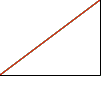



| |
 This all sounds very nice, but what's the use of this?
This all sounds very nice, but what's the use of this?
One thing you can do with the Pythagorean thereom is to calculate the length of any side of a right triangle if you know the other two.
For example, you have a right triangle with one leg measuring 3 inches and another leg measuring 4 inches. Can you find the size of the hypotenuse without drawing and measuring?
Did you get an answer? Here's my solution: The square which is along the side which has a length of 4 has an area of 16. (To get the area of a rectangle multiply the width by the height. A square is as wide as it is long. So multiply 4 by 4 which equals 16.) The area of the other square is 9 (3×3). This adds up to an area of 25. So which number can you multiply by itself to give 25? 5! The third side (the hypotenuse) therefore has a length of 5.
In this example all sides have lengths which are whole numbers. Can you find any other triangles where this is the case?
